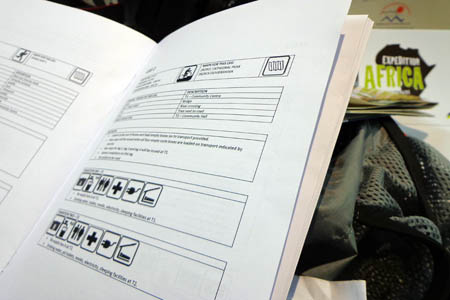
Here at Expedition Africa things are starting to move along swiftly. We met for the Opening Ceremony with team introductions at 13h00. I quite enjoy team introductions and with a field of 31 teams, it is just long enough to be enjoyable.
In fact, this was a bit of a stand-up comedy session with more than a few team-nominated representatives enjoying their time behind the microphone. The speaker introduced their teammates and said a few words – some about their racing ambitions and all about how delighted they were to be here in the Drakensberg. The Swedes are still rooting for snow; the Finns are looking for a good battle against the Swedes and a couple of South African teams are challenging each other to be at the back of the field, most notably Team Bad Medicine.
To paraphrase Mark Human, this team has been formed from the two ‘weaker’ members of teams Lickety-Split and Bad Medicine; and now they’re together and here to race. Hakuna Matata, a team from the Eastern Cape area, has challenged Bad Medicine for the back.
Photographer Bruce Viaene has posted team photos from the welcome on the KineticGear Facebook page.
Drakensberg Experience is the local tourism organisation and they’ve assisted Heidi and Stephan with permissions and elements for this event. Chris Hern said a couple of words of welcome and elicited knowing laughs from the locals when he recommended that the foreigners learn three useful Zulu words.
The first is “Sawubona”, which means hello.
The next two words are related to asking locals for directions.
“duze” (pronounced du-ze) means ‘close to’ and Chris says this can mean any location between here and Cape Town.
“kude” (pronounced gu-de) means ‘far from’ and Chris says this can mean any location between here and Nairobi.
Local racers laughed because anyone who has raced through our rural areas has certainly asked a local for directions to a school or settlement and has discovered the variable use of close or far – if they even get pointed in the right direction. You’ll have more luck with your map and grid searching.
Teams have received their Expedition Books. This valuable booklet guides them in preparing their re-supply boxes and planning mandatory gear for the various legs. No maps yet – only tomorrow evening. And they’ll only get maps for Leg 1. I can tell you tomorrow evening how many map handouts there will be – not yet.
They have been told that they go into the Royal Natal National Park on Day 1. This is the only place on the route where teams are restricted to staying on the established hiking trails. The boundary of the Park is indicated on their maps and once they’re out of the Park perimeter it is free for all. Sure, up top there are hiking trails but they’re not necessarily clear, maintained nor well defined. And they’re not the only trails. On top of the Berg, in Lesotho, it is cattle country and there are cattle trails all over the place.
Race director Stephan Muller pretty straight down the line, very organised and experienced. He has been racing himself for over 15 years, including Eco Challenge Borneo – back in the day. A Southern Traverse too. I find his race briefings to be quite funny – especially as he is totally dead-pan.
One comment that got a good giggle was his one about the teams being on top of the Berg. He described that funny feeling you get when someone is watching you. You turn around and see a Lesotho chap on a rise, blanket wrapped around his body, watching you.
“He may run after you,” says Stephan, “but just keep running”.
The locals are generally just interested in who you are and where you’re going.
When it comes to equipment inspections, Stephan is a man after my own heart. Mandatory gear is specified and the rest comes down to common sense. These racers are all adults and they have to take responsibility for their own safety. If they take an inadequate tent or sleeping bag and end up having a rough night in the mountains, that really is their problem.
Teams are provided with two large re-supply crates (A and B) as well as cardboard bike boxes and paddle bags. Boats too are provided by race organisation. These are near-indestructible plastic sit-on tops. The downside is that they’re not slinky racing kayaks that reward teams with good kayaking skills m but although slower, all teams have are – literally – in the same boat and less experienced teams can’t capsize.
I snuck in a lovely run this afternoon, making the best of what may be the last of our warm weather… There was a massive bank of cloud to the South-East and reports are in that there is snow in the Giant’s Castle / Champagne valley.

Looks like the Swedes may get their wish. Snow will certainly be a novelty for the South Africans. I just hope that they keep their focus on racing and not on making snowmen and throwing snowballs at each other.

Enjoying the running commentary. Keep it up!